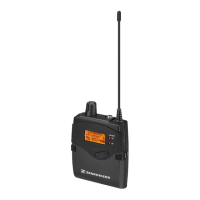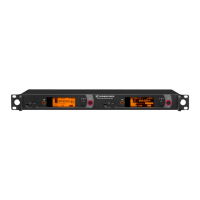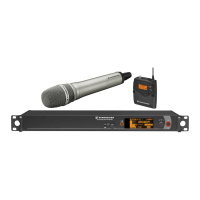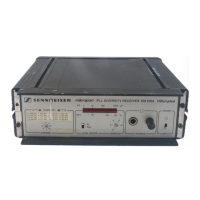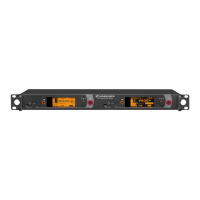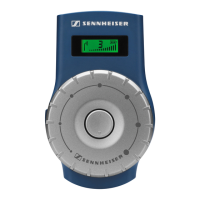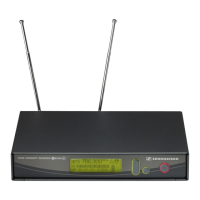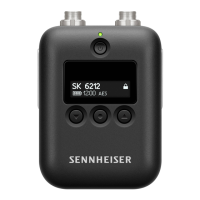Putting the receiver into operation
12
왘 Connect the rod antennas to the BNC sockets 씏.
Daisy-chaining receivers
The receivers feature an integrated antenna splitter so that up to 10 receivers can be daisy-
chained without any additional antenna splitters being required. Only daisy-chain receivers
from the same frequency range (see page 4).
왘 Connect the two supplied rod antennas or two remote antennas (optional accessories) to
the BNC sockets 씋 and 씎 of the first receiver.
왘 Use BNC cables to daisy-chain the receivers as shown in the diagram on the left.
Connecting an amplifier/mixing console
The receiver’s XLR-3M socket 쐉 and the ¼” (6.3 mm) jack socket 쐈 are connected in parallel.
왘 Use a suitable cable to connect the amplifier and/or the mixing console to the XLR-3M
socket 쐉 and/or the ¼” (6.3 mm) jack socket 쐈 (see also page 39).
왘 Via the operating menu of the receiver, adjust the audio output level to the input of the
amplifier or mixing console (see page 18). The adjusted audio output level is common for
both sockets.
Connecting receivers in a network
You can connect several receivers in a network. The receivers are remote controlled via a PC
running the “Wireless Systems Manager” (WSM) software. This software will assist in the
quick and safe configuration of multi-channel systems (see page 31).
왘 Use standard network cables (at least Cat 5) to connect the receivers via the LAN
socket 씉 to an Ethernet switch. Then connect the Ethernet switch to a PC (see diagram).
When a receiver is properly connected to the Ethernet switch or the PC, the yellow LED 씈
at the rear of the receiver lights up.
씏
RF IN RF INRF OUT
ANT II ANT I
RF IN RF INRF OUT
ANT II ANT I
씋
씎
• To supply an active directional antenna, a direct voltage (which cannot be
switched off) is output via the antenna sockets 씋 and 씎 of the receivers.
• In order to obtain a good reception quality, we recommend not to daisy-chain
more than 10 receivers.
• If you set a daisy-chained receiver to standby mode (see “Switching the receiver
on/off” on page 14), the integrated antenna splitter remains active.
+18dBu MAX ETHERNET RJ-45
B
TRANS-BAL
AF OUT B
쐈
쐉
WSM
543.200
B.Ch: 20.64
PEAK
MUTE
EQ:
+ 12dB
P
-10
040
30
20
10
-20
-30
-40
AF
RF
MHz
True Diversity Receiver EM 2000
**2000**
SKM2000
543.200
B.Ch: 20.64
PEAK
MUTE
EQ:
+ 12dB
P
-10
040
30
20
10
-20
-30
-40
AF
RF
MHz
True Diversity Receiver EM 2000
**2000**
SKM2000
543.200
**2000** **2000**
B.Ch: 20.64
PEAK
MUTE
EQ:
+ 12dB
P
-10
040
30
20
10
-20
-30
-40
AF
RF
MHz
543.200
B.Ch: 20.64
PEAK
MUTE
EQ:
+ 12dB
P
-10
040
30
20
10
-20
-30
-40
AF
RF
MHz
True Diversity Receiver EM 2050
SKM2000 SKM2000
The EM 2050 twin receiver has a separate LAN socket 씉 for each receiver.

